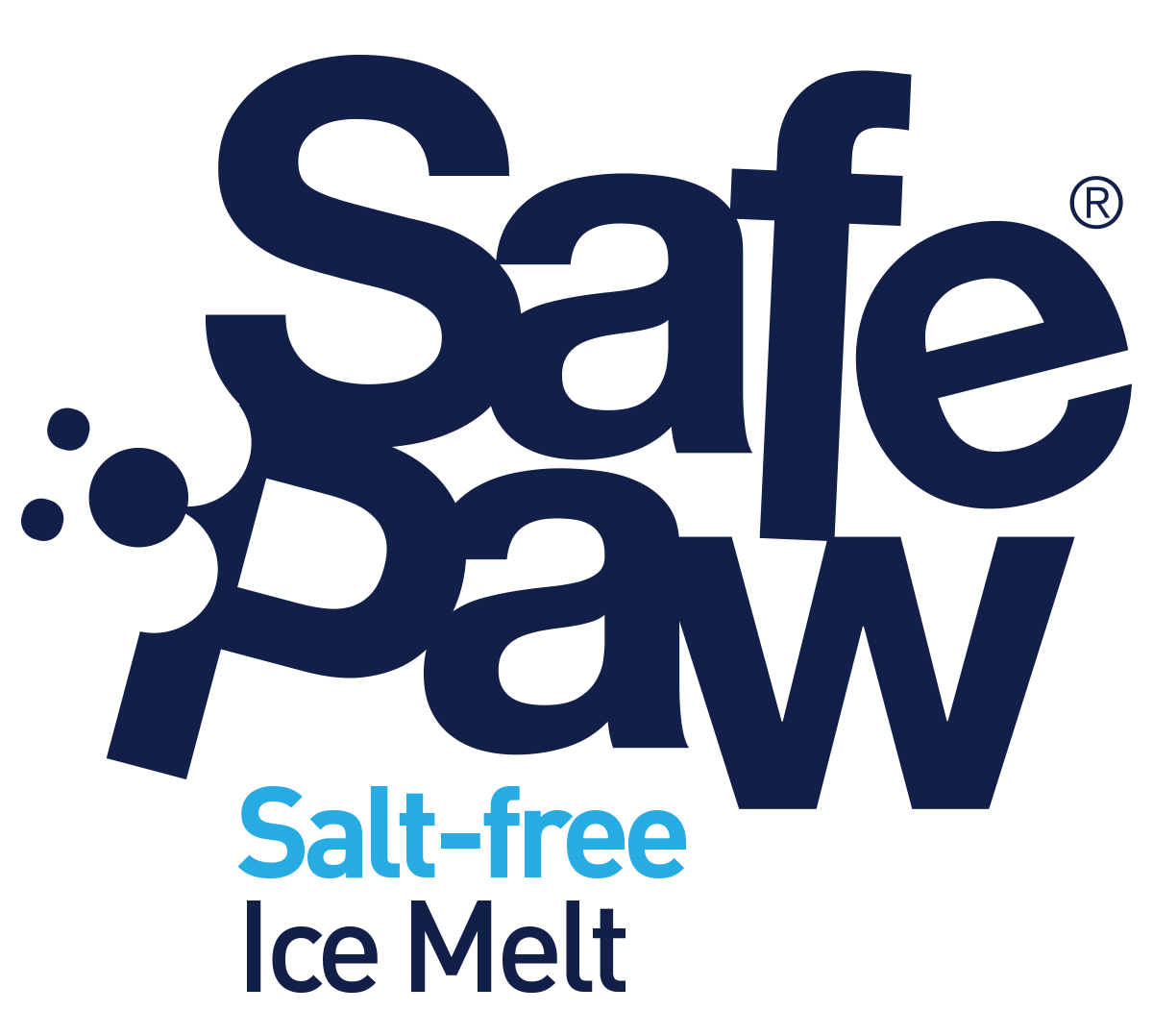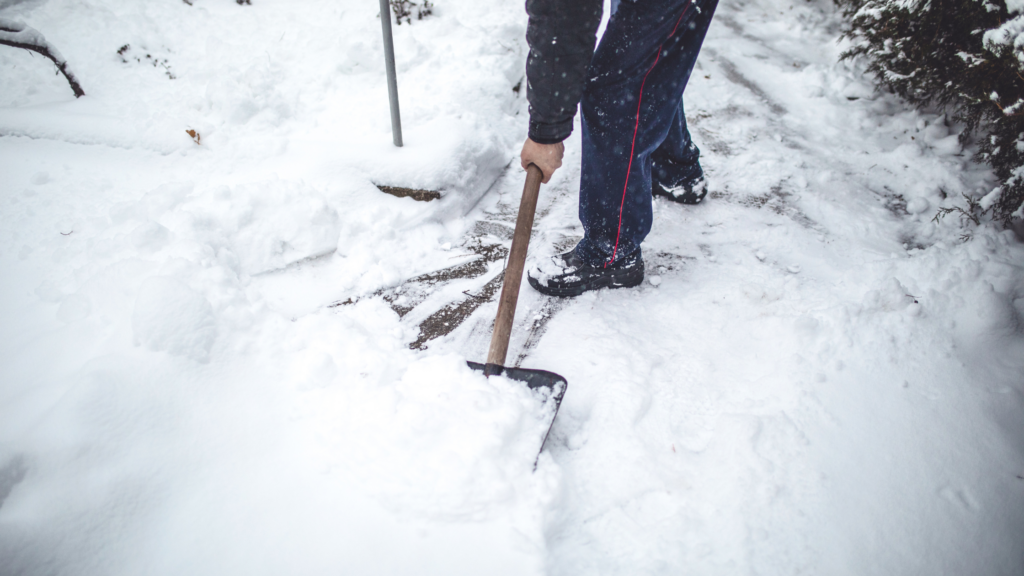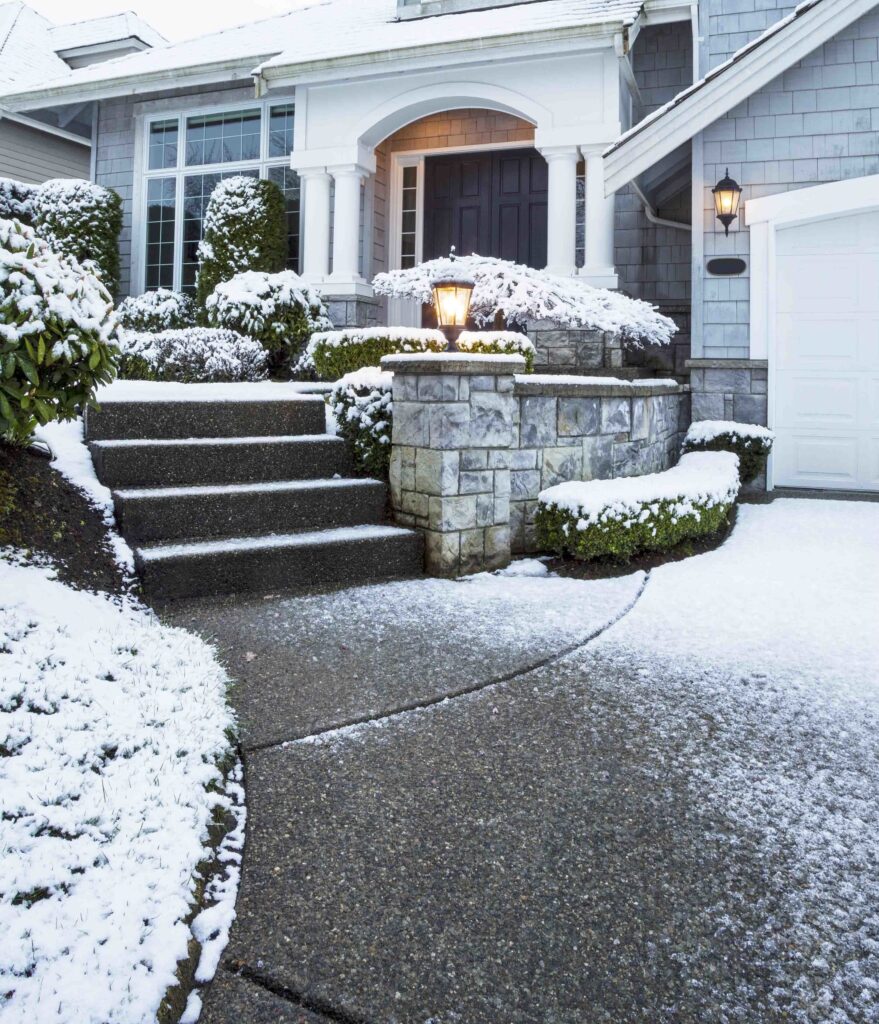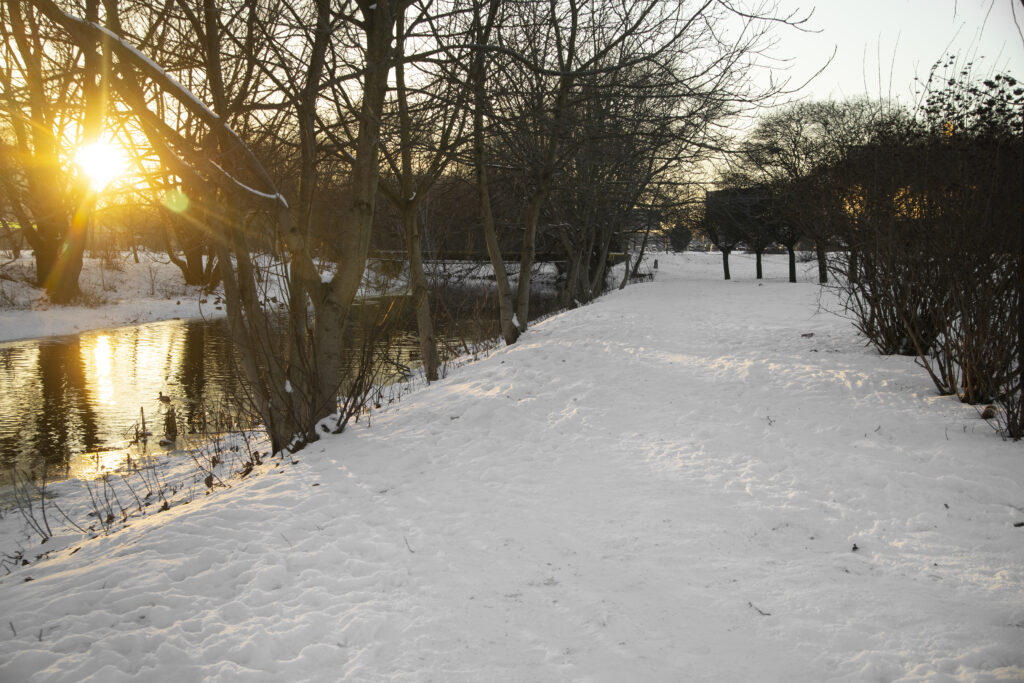
Winter brings a host of challenges for homeowners, with icy driveways being a top concern. Many turn to salt for concrete as a go-to de-icing solution, but what if the very product meant to protect your driveway is causing long-term damage? Here’s an in-depth look at how salt impacts concrete, how to identify early signs of damage, and the best alternatives to keep your property safe.
Table of Contents
Understanding the Freeze-Thaw Cycle and Its Impact on Concrete
Concrete, despite its strength, is porous and susceptible to damage during the freeze-thaw cycle. Here’s how it works:
- Water Infiltration: When water from melted snow and ice seeps into the pores of concrete, it settles inside the surface.
- Freezing and Expansion: As temperatures drop, the trapped water freezes and expands. This expansion creates internal pressure.
- Cracking and Spalling: Over time, this repeated cycle of freezing and thawing leads to surface cracking, spalling (flaking), and even structural damage.
Using salt for concrete exacerbates this process. Salt lowers the freezing point of water, causing more frequent freeze-thaw cycles, accelerating the rate of deterioration.
Get ready for winter with Safe Paw: The Pet-Friendly Ice Melter that cares – for your home, pets, and planet.
Chemical Reactions Between De-Icing Salts and Concrete Components
Beyond the mechanical damage caused by freeze-thaw cycles, de-icing salts can chemically interact with concrete. Sodium chloride (rock salt) and calcium chloride, commonly found in traditional ice melts, are particularly problematic.
- Chloride Penetration: Chlorides penetrate the concrete and corrode the steel reinforcements inside. This weakens the structural integrity of the driveway or walkway.
- Alkali-Silica Reaction (ASR): Salts can react with the silica in concrete, creating an expansive gel that leads to cracks and surface scaling.
- Calcium Leaching: Calcium chloride can extract calcium hydroxide from the concrete, leaving the material more porous and prone to damage.
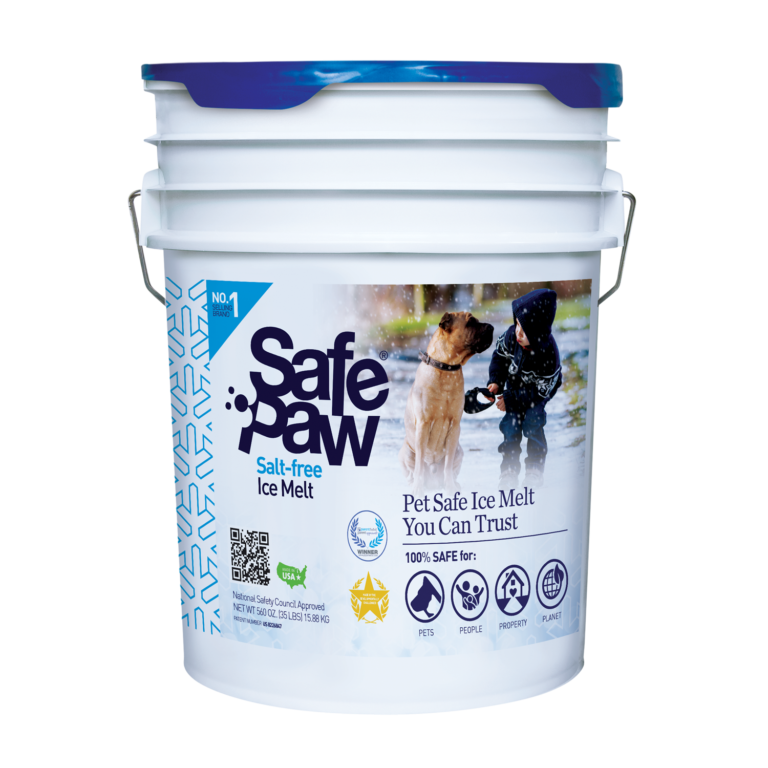
Safe Paw
It is a pet-friendly, eco-friendly ice melt that is safe for your family, pets, and property. It is made with a unique formula that is gentle on paws and concrete, and it melts ice and snow quickly and effectively.
Safe Paw is the perfect choice for winter weather!
Identifying Early Signs of Salt-Induced Concrete Damage
Spotting damage early can save you from costly repairs. Here are some signs to watch for:
- Surface Scaling: Flaking or chipping of the concrete surface is a common indicator.
- Discoloration: White stains or darkened patches may signal salt residue or moisture infiltration.
- Small Cracks: Hairline fractures can quickly expand if not addressed.
- Pitting: Small holes on the surface are often caused by salt-induced chemical reactions.
If you notice these signs, taking immediate action can prevent further deterioration.
Exploring Eco-Friendly and Concrete-Safe De-Icing Alternatives
Switching to eco-friendly and best ice melt for concrete products is the best way to protect your driveway. One standout solution is Safe Paw, a salt-free and chloride-free ice melt designed with safety and effectiveness in mind.
- Non-Corrosive: Safe Paw doesn’t harm concrete or metal reinforcements.
- Pet and Child Safe: It’s non-toxic and gentle, making it ideal for households with pets and kids.
- Effective in Cold Temperatures: Safe Paw works in extreme cold, down to -19°C (-2°F), ensuring reliable de-icing.
By using Safe Paw, you not only preserve your driveway but also reduce harm to the environment and surrounding vegetation.
Get ready for winter with Safe Paw: The Pet-Friendly Ice Melter that cares – for your home, pets, and planet.
Best Practices for Protecting Concrete Surfaces During Winter
To ensure your concrete surfaces survive winter intact, consider these practical tips:
- Seal Your Driveway: Apply a high-quality sealant before winter to create a barrier against water and chemicals.
- Shovel Regularly: Clear snow promptly to minimize ice buildup and reduce reliance on de-icers.
- Use De-Icers Sparingly: Even with concrete-safe products like Safe Paw, use only as much as necessary.
- Perform Regular Maintenance: Address small cracks or scaling as soon as they appear to prevent larger issues.
Mag Chloride vs Salt: Does Switching Really Solve the Problem?
By now, most homeowners understand that salt isn’t exactly a friend to concrete. But what about magnesium chloride—often praised as a “safer” choice? When we compare mag chloride vs salt, it’s important to look at what’s happening beneath the surface. Magnesium chloride does tend to be less corrosive than sodium chloride, which is why it’s used in some municipalities for road treatment. But here’s the catch: it still works by pulling moisture into the concrete’s pores. That water later freezes, expands, and eventually causes the very damage you’re trying to avoid.
So, does that mean magnesium chloride is better than salt? In the short term, it may reduce immediate scaling. But in the long run, it still contributes to deterioration and leaves behind chloride residues that affect both concrete and surrounding soil. In other words, it’s not really a solution—it’s more like a slower version of the same problem.
Best Salt for Concrete Driveway: A Misleading Promise
Walk into any hardware store in January, and you’ll see shelves of bags promising to be the best salt for concrete driveway. The packaging may boast about being “concrete safe” or “formulated to protect surfaces.” But let’s be honest: if it’s still a chloride-based product, it’s playing the same game with different rules.
Concrete is porous by nature, and once melting salt dissolves, it creates brine that seeps into every micro-crack. When the freeze-thaw cycle kicks in, the expansion from refreezing water applies pressure that the concrete simply can’t withstand forever. Even so-called “safer” blends accelerate pitting and scaling when used repeatedly through a harsh winter.
The real question isn’t which salt is “best.” It’s whether salt has any business being on concrete at all. A smarter approach is shifting away from chloride-based products entirely, using engineered solutions that melt ice without setting up this destructive cycle. That’s where eco-friendly, non-corrosive options come into play.
Get ready for winter with Safe Paw: The Pet-Friendly Ice Melter that cares – for your home, pets, and planet.
Animal Safe Salt: Marketing vs Reality
Here’s another concern that often gets overlooked: pets. You may have noticed bags labeled as animal safe salt, and at first glance, they sound like the perfect compromise. But look closer, and you’ll usually find that the claim means “less harmful,” not “truly safe.”
Even if a formula reduces irritation, pets can still experience dryness, cracked paw pads, and stomach upset after ingesting residues. Dogs, for example, often lick their paws after a walk—so even trace amounts of chloride can lead to vomiting or worse. And if you’ve ever had to make a rushed winter trip to the vet, you know that “less harmful” is not the same as “safe.”
That’s why genuinely salt-free options are worth considering. They eliminate the worry entirely, rather than leaving you to gamble with your pet’s health every time they step outside. After all, your driveway should be safe for the whole family—including the four-legged members.
Melting Salt and the Freeze-Thaw Trap
It’s also worth diving deeper into how melting salt actually affects concrete on a chemical level. Every time salt lowers the freezing point of water, it’s creating conditions for more liquid to remain unfrozen at temperatures where it would normally solidify. That sounds like a good thing—until the next cold snap.
When the temperature plunges again, all that water trapped in the pores freezes, expands, and pushes outward. That’s why you start noticing tiny cracks that eventually become large fractures. In essence, using salt doesn’t just respond to winter conditions—it actually intensifies the cycle that destroys concrete.
Homeowners often think, “If I just use a little, it won’t hurt.” But over the course of multiple winters, the damage accumulates. That white residue you sweep up every spring? It’s a visible reminder of the chemical reactions happening beneath the surface.
Looking Beyond Salt: Smarter Choices for Long-Term Protection
If salt isn’t the answer, and magnesium chloride isn’t much better, what should you use instead? More homeowners are turning toward chloride-free products designed specifically to break the bond between ice and concrete without triggering corrosive reactions. These formulas don’t pull water into the pores and don’t leave behind harmful residues.
Pairing these solutions with simple prevention strategies—like sealing your driveway before winter or clearing snow promptly—can go a long way. And for those who want to minimize their dependence on chemicals altogether, heated mats and snow-melting systems are becoming more accessible options. They require an upfront investment but can save thousands in repairs and replacements over the years.
Conclusion
When you put it all together, the argument becomes clear: there’s really no such thing as the best salt for concrete driveway if it still relies on chloride chemistry. Whether you compare mag chloride vs salt or reach for a bag labeled animal safe salt, the results end up looking the same—gradual concrete damage, environmental stress, and risks to pets.
The smarter path is to step away from melting salt altogether and embrace alternatives that do their job without compromise. Winter safety doesn’t have to come at the expense of your driveway, your pets, or the environment. By making a thoughtful switch now, you protect not just the surface under your feet but also the long-term health of your home and family.
Try Our Other Winter Safety Products
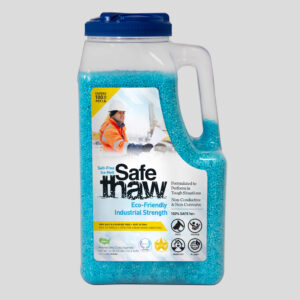
Safe Thaw
Safe Thaw was created as the ice management solution for tough winter environments. Ideal in commercial and industrial properties, shops, government agencies, bridges, construction. It’s 100% Salt-Free and Chloride-Free.
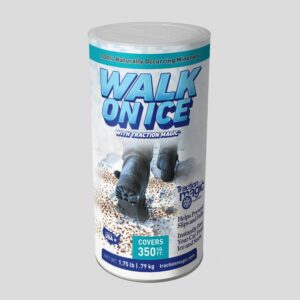
Walk On Ice
The slip and fall prevention solution, for any icy or snowy surface, on a handy portable package! Lightly spread around your walkway, driveway, vehicle, tires, and pathways. Turn ANY icy surface instantly, into a non-skid, slip-free surface.
